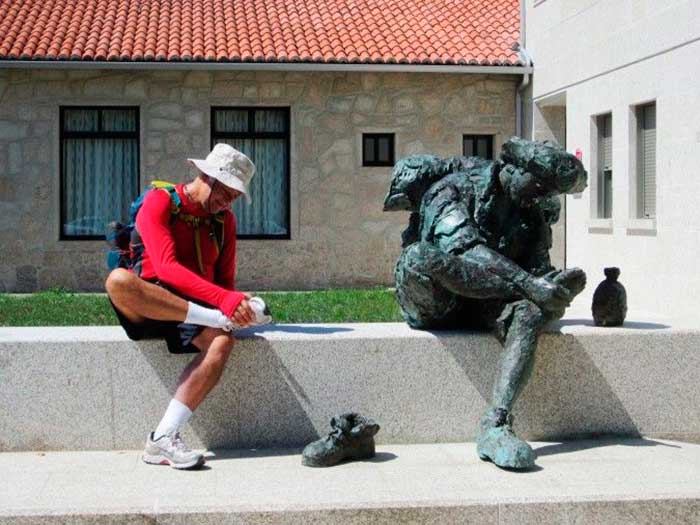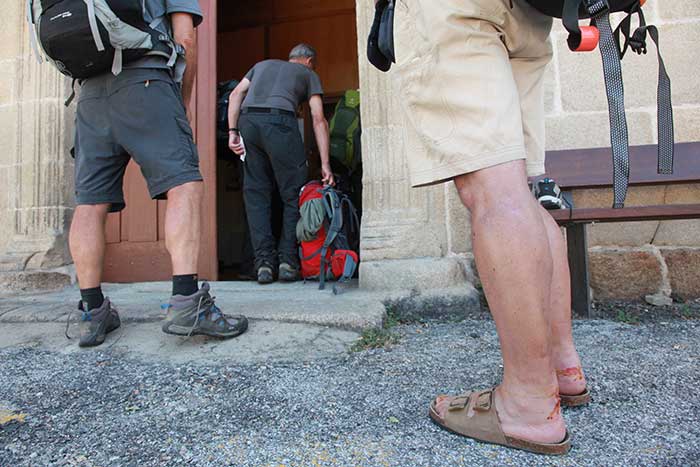When you walk over hard rough surfaces for more than 20 kilometers a day, you’re going to get blisters. And bruises, and pulled muscles, and perhaps sprains or worse. You can’t tough it out when you have to walk again tomorrow. Take care of yourself, especially your feet.

Remember that there are plenty of “farmacias” in Spain and France on the Camino Frances, and other Caminos. The pharmacists along the camino are quite accustomed to most of the aches, pains and ills of peregrinos and will be able to help you with most maladies.
Useful tips:
- Take any prescribed medication with you but only small quantities of other things as you can top up along the way.
If you are, or ever have been, allergic to anything – whether it be flora or food – carry anithistamines. Non-drowsy for the day and drowsy for night (so that you can sleep through the snoring!)
If you have ever had asthma – even if you haven’t had an attack for 10 years – take something with you. Your body has learned to fight local conditions but you will be in a new country with different dust, pollens etc and these could cause problems. - Build up your reserves of Magnesium and Calcium before you go. Just as you would service your car before a long journey, your body will need a good top up too! (Dolomite is a good source.)
- Take pills etc out of the boxes and pack them into plastic, zip-lock money bags. You can decant liquids such as Arnica oil from their heavy glass bottles into smaller, plastic bottles. (They will remain stable for the short time you are walking on the camino.)
- If you are walking with a friend, share the first aid list. One can carry the pills for whoopsing, the other for poopsing etc!
And, please, take a plastic packet for toilet tissues and discard in a bin – not on the path.

It’s very true to say that there are many pharmacies along the way and that they stock a far wider range of medications than you will find in any store. Many things that are prescription only in those countries are OTC in Spain. Its also usually cheaper there.
However, it’s also true that first aid kits are firstly for emergencies and many emergencies will not happen anywhere near a pharmacy. Besides, splitting the kit between people to “save weight” is not a particularly great idea, purely because if you part company for any reason and forget you have stuff split…you may find you need what the other person has and cant get it.

Here there is a list of common first aid you are likely to need:
Crepe bandages – useful for bandaging swollen ankles, holding larger dressings on or as a sling if need be.
Plasters: a small pack of plasters, get the silver healing ones if possible they really do speed up healing. Dont leave raw blisters on your hands (from sticks) or cuts/bad scrapes exposed to the air for two reasons; in a hot climate it will get infected very quickly and secondly, if you allow it to scab over, your skin then has to push a hard scab out of the way to heal. It is accepted medical practice to keep a wounds very slightly moist, and clean, to enable faster healing.
Compeed – any time something feels like it’s rubbing, or a hot spot put on a compeed, this should prevent an actual blister. and Compeed for smaller ones or as a preventative when you feel one forming.
Needle & Thread for blisters -Once a large blister forms I found Compeed made things worse. Leaving it to drain with thread was a much better idea as long as you keep it clean with…. – personal choice is to thread the blister, so thread the needle, put needle in one side of blister and out the other leaving the thread hang out both sides and hopefully wake up in the morning blister will have drained and not refilled as can happen if you just prick it. However, some people don´t like popping blisters with a needle and they only use needles for splinters or mending.
Painkillers – Ibubrofen ideally as this is an anti inflammatory and therefore ideal for swollen ankles as well as headaches. Voltaren creme and fisiocreme (bought in spain, against muscle ache)
Antiseptic spray: small bottle. Dont take ointment because its heavier, and it’s greasy and may cause you other problems. Best not to touch the affected area if possible so a spray is better.
Compress bandage: light, easily packed, takes up almost no space and is adaptable for a wide range of things from little toe blisters to more serious injuries.

Diclofenac lotion: Optional and you only need it if you get tendonitis…but if you do then get it there as its very cheap and amazingly good for swollen or painful joints!
Anti – histamine: for mosquito bites and other allergies. On a side note rubbing the inside of banana peel on bites is supposed to work very well. Apparently you rub it on and leave it for a couple of hours…worth a go!
You can take scissors or a small swiss army knife – and a small pair of tweezers, too.
Micropore or -elasticated adhesive bandage to hold the crepe bandage round akles or turn cut up bits of compress into plasters for awkward areas.
That should do it! the kit isnt that big and really doesnt weight too much but could make a huge difference to your trip.
Buen Camino, amigos!
Anxo Saco



Comments